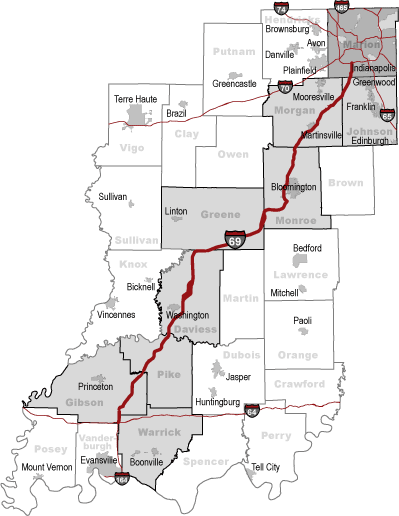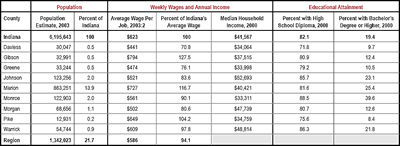I-69 Corridor in Southwest Indiana Receives Federal Approval
In March 2004, federal approval of the I-69 corridor connecting Evansville and Indianapolis made the new interstate a soon-to-be reality for the 1.3 million people living in the nine counties the corridor runs through; that is, if one’s definition of soon encompasses the next eight to fourteen years.
The approved corridor is to improve access to communities and businesses throughout southwest Indiana by linking Daviess, Gibson, Greene, Johnson, Marion, Monroe, Morgan, Pike, and Warrick counties (see Figure 1). I-69 would also be particularly important to the Crane Naval Surface Warfare Center in neighboring Martin County.
Figure 1
I-69 Corridor in Southwest Indiana
Click on a county to access its IN Depth Profile

Of the nine counties in the I-69 corridor, three counties have average weekly wages that exceed Indiana’s (Gibson, Marion, and Pike), but the overall regional weekly wage of $586 is just 94.1 percent of the state average (see Table 1). At $441 a week, those in Daviess County earned the least, receiving just 70.8 percent of the state average.
Table 1
Demographic Overview of Counties in I-69 Corridor
Click to view larger image
When looking at median household income from Census 2000, it was Monroe County that came in at the bottom at $33,311, likely due to the Indiana University (IU) student population. Greene, Daviess, and Pike counties also had median incomes below $35,000. Six of the nine counties had median household incomes below the state median of $41,567.
Educational attainment varies from Daviess County, where nearly 30 percent of the population over age twenty-five has not completed high school, to Monroe County, where 39.6 percent have a bachelor’s degree or higher (once again, because of the presence of IU).
During the next phase of the I-69 project, final alignment will determine the exact route within the two-thousand foot buffer zone. The 142-mile corridor will be broken into six sections, and local officials and residents along the route will help plan and design the highway that works best for their respective communities.
The Indiana Department of Transportation estimates I-69 will cost $1.78 billion to build, with 80 percent of that paid with federal funds and 20 percent paid with state gas tax revenues.




